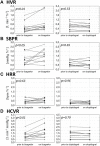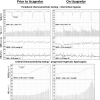The effects of P2Y12 adenosine receptors' inhibitors on central and peripheral chemoreflexes
- PMID: 37538377
- PMCID: PMC10394699
- DOI: 10.3389/fphys.2023.1214893
The effects of P2Y12 adenosine receptors' inhibitors on central and peripheral chemoreflexes
Abstract
Introduction: The most common side effect of ticagrelor is dyspnea, which leads to premature withdrawal of this life-saving medication in 6.5% of patients. Increased chemoreceptors' sensitivity was suggested as a possible pathophysiological explanation of this phenomenon; however, the link between oversensitization of peripheral and/or central chemosensory areas and ticagrelor intake has not been conclusively proved. Methods: We measured peripheral chemoreceptors' sensitivity using hypoxic ventilatory response (HVR), central chemoreceptors' sensitivity using hypercapnic hyperoxic ventilatory response (HCVR), and dyspnea severity before and 4 ± 1 weeks following ticagrelor initiation in 11 subjects with chronic coronary syndrome undergoing percutaneous coronary intervention (PCI). The same tests were performed in 11 age-, sex-, and BMI-matched patients treated with clopidogrel. The study is registered at ClinicalTrials.com at NCT05080478. Results: Ticagrelor significantly increased both HVR (0.52 ± 0.46 vs. 0.84 ± 0.69 L min-1 %-1; p < 0.01) and HCVR (1.05 ± 0.64 vs. 1.75 ± 1.04 L min-1 mmHg-1; p < 0.01). The absolute change in HVR correlated with the change in HCVR. Clopidogrel administration did not significantly influence HVR (0.63 ± 0.32 vs. 0.58 ± 0.33 L min-1%-1; p = 0.53) and HCVR (1.22 ± 0.67 vs. 1.2 ± 0.64 L min-1 mmHg-1; p = 0.79). Drug-related dyspnea was reported by three subjects in the ticagrelor group and by none in the clopidogrel group. These patients were characterized by either high baseline HVR and HCVR or excessive increase in HVR following ticagrelor initiation. Discussion: Ticagrelor, contrary to clopidogrel, sensitizes both peripheral and central facets of chemodetection. Two potential mechanisms of ticagrelor-induced dyspnea have been identified: 1) high baseline HVR and HCVR or 2) excessive increase in HVR or HVR and HCVR. Whether other patterns of changes in chemosensitivities play a role in the pathogenesis of this phenomenon needs to be further investigated.
Keywords: P2Y12 adenosine receptor inhibitors; carotid body; central chemoreflex; clopidogrel; dyspnea; peripheral chemoreflex; ticagrelor.
Copyright © 2023 Tubek, Niewinski, Langner-Hetmanczuk, Jura, Kuliczkowski, Reczuch and Ponikowski.
Conflict of interest statement
ST: speaker honoraria from AstraZeneca. KR: speaker honoraria from AstraZeneca. PP reports personal fees from Boehringer Ingelheim, AstraZeneca, Servier, Bristol Myers Squibb, Amgen, Novartis, Merck, Pfizer, Berlin-Chemie, and grants and personal fees from Vifor Pharma. The remaining authors declare that the research was conducted in the absence of any commercial or financial relationships that could be construed as a potential conflict of interest.
Figures





Similar articles
-
Analysis of Hypoxic and Hypercapnic Ventilatory Response in Healthy Volunteers.PLoS One. 2017 Jan 3;12(1):e0168930. doi: 10.1371/journal.pone.0168930. eCollection 2017. PLoS One. 2017. PMID: 28045995 Free PMC article.
-
Changes in ventilatory responses to hypercapnia and hypoxia after intermittent hypoxia in humans.Respir Physiol Neurobiol. 2005 Mar;146(1):55-65. doi: 10.1016/j.resp.2004.11.007. Respir Physiol Neurobiol. 2005. PMID: 15733779 Clinical Trial.
-
Relationship between breathlessness and hypoxic and hypercapnic ventilatory response in patients with COPD.Eur Respir J. 1996 Nov;9(11):2340-5. doi: 10.1183/09031936.96.09112340. Eur Respir J. 1996. PMID: 8947082
-
The risk of dyspnea in patients treated with third-generation P2Y12 inhibitors compared with clopidogrel: a meta-analysis of randomized controlled trials.BMC Cardiovasc Disord. 2020 Mar 17;20(1):140. doi: 10.1186/s12872-020-01419-y. BMC Cardiovasc Disord. 2020. PMID: 32183711 Free PMC article.
-
Ticagrelor: an investigational oral antiplatelet treatment for reduction of major adverse cardiac events in patients with acute coronary syndrome.Vasc Health Risk Manag. 2010 Oct 21;6:963-77. doi: 10.2147/VHRM.S13263. Vasc Health Risk Manag. 2010. PMID: 21057581 Free PMC article. Review.
Cited by
-
Blood oxygen regulation via P2Y12R expressed in the carotid body.Respir Res. 2024 Jan 27;25(1):61. doi: 10.1186/s12931-024-02680-x. Respir Res. 2024. PMID: 38281036 Free PMC article.
-
Translating physiology of the arterial chemoreflex into novel therapeutic interventions targeting carotid bodies in cardiometabolic disorders.J Physiol. 2025 May;603(9):2487-2516. doi: 10.1113/JP285081. Epub 2025 Apr 5. J Physiol. 2025. PMID: 40186613 Free PMC article. Review.
-
Respiratory, thoracic, and mediastinal adverse events associated with ticagrelor: A pharmacovigilance study based on FDA adverse event reporting system.Naunyn Schmiedebergs Arch Pharmacol. 2025 Jul 16. doi: 10.1007/s00210-025-04428-w. Online ahead of print. Naunyn Schmiedebergs Arch Pharmacol. 2025. PMID: 40668413
References
-
- Agarwal A., Kim I., Carroll J. (2011). Atp inhibits carotid body glomus cell hypoxia response via P2y12 receptors. Am. J. Respir. Crit. Care Med. 183, A2484. 10.1164/ajrccm-conference.2011.183.1_MeetingAbstracts.A2484 - DOI
-
- Armstrong D., Summers C., Ewart L., Nylander S., Sidaway J. E., van Giezen J. (2014). Characterization of the adenosine pharmacology of ticagrelor reveals therapeutically relevant inhibition of equilibrative nucleoside transporter 1. J. Cardiovasc. Pharmacol. Ther. 19, 209–219. 10.1177/1074248413511693 - DOI - PubMed
LinkOut - more resources
Full Text Sources
Miscellaneous

